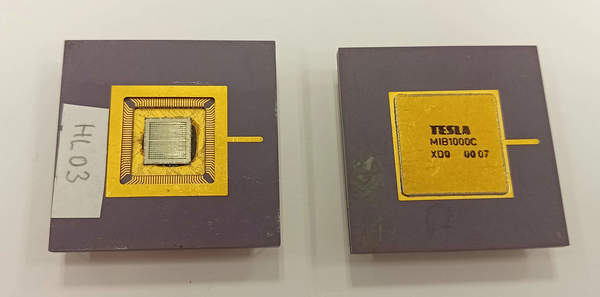HP1000

The gate field developed in cooperation with VÚMS and Tesla Rožnov (this chapter does not discuss the computer of the same name from Hewlett-Packard). The field function was defined by the last metallic layers that connected the individual elements of the "lower" lithographic structures, and this created the resulting circuit, denoted ZIO or PZIO (semi-custom integrated circuit). According to the circuit datecode, it was produced around 1989.
The basic chip had dimensions of 7.55 x 7.25 mm and its first version was mounted in a PGA 120 ceramic package. The operating temperature range was 0–70° C. The integrated circuit required two external supply voltages (+5.0 V and +2 .4 V) as well as two groundings that were connected to increase the noise resistance up to the printed circuit board. The pins of both countries were brought out through the 8 pins of the PGA 120 case, the +5V power was brought out through the 4 pins, the +2.4V power through the 8 pins.
Input and output converters were distributed around the perimeter of the chip, the levels corresponded to the levels of the 74ALS series. There were 92 input converters on the chip, and about 64 usable output converters. A matrix of 32 columns and 34 rows was created inside the chip, i.e. a total of 1,088 cells, from which it was possible to create different types of gates. Four clock pulse amplifiers were also created on the chip for the distribution of signals with high branching.
The connection of gates and converters into a logical network was realized in two layers of metallization. At the same time, three masks were designed according to the customer: one mask for interconnection mainly in the X - direction, the second mask for interconnection mainly in the Y - direction and the third mask for interlayer interconnection. Basic functional elements such as NAND, AND, AND – OR gates, input converters, output converters and clock pulse amplifiers were available.
The main developers of the HP1000 include Eduard Kottek, Vladimír Šťastný, Jan Křivohlávek, František Kudrna and Miroslav Pěchouček.
MIB1000C
Semi-custom integrated circuits MIB1000C were developed on the basis of HP1000.
The circuit implemented digital control in a closed loop of the servomotor for controlling the drive for paper movement in one coordinate axis or for moving a carriage with a drawing pen in the second coordinate axis of a cylindrical drawing device of format A0 to A4 type VZ 565 – CM 6426 or a cylindrical drawing device of format A3 type VZ 300. In the control of each cylindrical drawing device, the circuit was used twice – separately for each always together with control microprocessor type 8086.
MIB1000C/0202
The circuit implemented similar functions to those built on the smaller HP200 gate array (HP221 and HP222) together in one package, but for an 80286 type microprocessor.
References
- https://stm-ke.sk/asset/uploads/vystavy/Historia_vyroby_elektronickych_s.pdf (WebArchive)
- http://www.ebastlirna.cz/modules.php?name=Forums&file=viewtopic&t=36066 (WebArchive)
- Aktuality výpočetní techniky č. 66 (1988)
- Aktuality výpočetní techniky č. 76 (1991)
- Ing. Miroslav Pěchouček, CSc. Aktuality výpočetní techniky č. 74/16 Diagnosticky vybavené obvody pro HP1000
- Ing. Jan Rada Aktuality výpočetní techniky č. 74/23 Algoritmy generátoru testů hradlových polí HP1000
- Ing. Daniel Nevečeřal, Ing. Vanda Růžičková, Ing. Jaroslav Tůma, Aktuality výpočetní techniky č. 74/28 Prostředky pro testování desek s hradlovými poli
- Marie Vlčková, Zdeněk Korvas. Návrh počítače s hradlovými poli HP1000. Konference ve Vrátné dolině, Žilina, 1988
- Sdělovací technika: měsíčník pro rozvoj a praxi sdělovací elektrotechniky. Praha: Státní nakladatelství technické literatury, 11.1990, 38(11), s. 437. ISSN 0036-9942. Dostupné také z: https://ndk.cz/uuid/uuid:b07c5780-b889-11e9-b601-005056825209